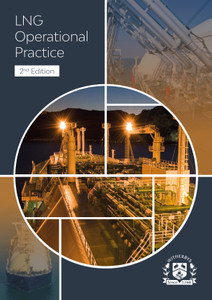
This publication details the rules, regulations and procedures that should be followed when preparing for pilot embarkation and disembarkation. It includes relevant excerpts from SOLAS regulations and IMO resolutions. The text is supported by explanatory photographs and diagrams that demonstrate good and bad practice.
This second edition supersedes both the basic and advanced editions of Pilot Ladder Manual.
This publication provides ship Masters and crew with a comprehensive understanding of the equipment, safety requirements and regulations necessary to conduct a proper risk assessment of pilot transfer operations.
Topics covered include the responsibilities of all personnel involved in pilot transfer, ladder construction and combination ladders, and examples of inadequate securing of a ladder. The guide explains the technical details of carrying out pilot transfer operations and includes important safety observations and comments. It includes text of SOLAS V, Regulation 23 Pilot Transfer Arrangements, IMO Resolution A.1045(27) on Pilot Transfer Arrangements, the UK Code of Safe Working Practices for Merchant Seafarers and the ISO 799 requirements for pilot ladders.
Throughout the world, at any time of day or night, in good or adverse weather conditions, a number of marine pilots will be in transit either to or from vessels that they have been engaged to safely navigate from one location to another. Each of these pilots will need to be safely embarked or disembarked from their vessel. There are a number of ways in which this transfer operation can be completed, each involving a certain degree of risk.
It is critical that all involved in pilot transfer are fully aware of the dangers that exist. Only through effective training and education can pilot transfer operations be made safer, irrespective of the transfer method used.
Pilot embarkation and disembarkation normally take place when the vessel is underway or alongside a berth, but may also take place when the vessel is at anchor. Possible transfer methods include by pilot boat, helicopter or directly from the shore. Transfer may be facilitated by the vessel's accommodation ladder, gangway or vehicle ramp, or possibly by crane basket. However, the most common method is by traditional wooden pilot ladder, and this method of transfer is the main focus of this publication.
Despite the best efforts of the International Maritime Pilots' Association (IMPA), various regional and national pilot associations, and the International Maritime Organization (IMO), there continue to be far too many reports of poorly rigged or unsafe pilot ladders. In recent years, a significant number of pilots have been fatally or seriously injured as a direct result of accidents occurring during embarkation or disembarkation.
IMPA represents the international community of marine pilots and as such promotes effective safety outcomes in pilotage. Periodically, IMPA conducts safety campaigns which collate details of pilot transfer compliance in accordance with internationally agreed standards.
The aim of this publication is to remind all in the maritime industry of the vital importance of adhering to the rules and established procedures when preparing for embarkation and disembarkation of pilots.
About the Author
Meanings of Symbols used in this Manual
Author's Introduction
1. General Responsibilities of all Involved in Pilot Transfer
1.1 Regulations Applicable to Pilot Transfer Arrangements
1.2 Pilot Boarding Grounds
1.3 Owners and Ship Management Companies
1.4 On Board the Vessel
1.5 Pilotage Services
1.6 Pilots
1.7 Pilot Boat Crew
2. Pilot Ladder Construction
2.1 Certifi cation and Markings
2.2 Requirements for Effective Design and Construction
3. Securing the Pilot Ladder
3.1 Examples of Inadequate Securing
3.2 The Use of Shackles as a Securing Method
4. Access to the Deck
4.1 Handholds and Stanchions
4.2 Bulwark Ladders and Platforms
4.3 Low Freeboard Transfers
4.4 Unsafe Pilot Ladder Example
5. Supervision
6. Shipside Doors
7. Combination Ladders
7.1 Securing Combination Ladders
7.2 Platform of the Accommodation Ladder
7.3 Trapdoor Designs and Other Considerations
8. Associated Equipment and Lighting
8.1 Lighting
9. Pilot Ladder Winch Reels
10. Annexes
Annex 1 - SOLAS V, Regulation 23 - Pilot Transfer Arrangements
Annex 2 - IMO Resolution A.1045(27)
Annex 3 - IMO Resolution A.1108(29)
Annex 4 - Technical Drawings
Annex 5 - Rolling Hitch
Annex 6 - Retrieval Line Poster
Annex 7 - Checklists
Kevin Vallance began his seagoing career at the age of 16 with Shaw, Savill & Albion Co Ltd. After completion of his deck officer cadetship at Warsash School of Navigation, he was employed as second mate with South Coast Shipping Co, working on marine aggregate suction dredgers in the Limited European Trading Area. At the age of 28, after obtaining a Limited European Trade command endorsement, he was promoted to Master with that company, a role he held for 19 years.
At the age of 45, Kevin returned to South Tyneside College to complete his Masters foreign-going unlimited certificate of competency.
In 2006, he became a Trinity House Licensed Deep Sea Pilot, working with George Hammond Shipping of Dover. As a deep sea pilot, Kevin has worked on board a variety of vessel types, including ultra-large container vessels, tankers, bulk carriers, cruise ships, car carriers and visiting warships. His specialised local knowledge has also been utilised to assist with VTS services for cable and pipe-laying operations and salvage works. This varied work has been with many different and often multi-national crews.
Kevin was elected to the United Kingdom Maritime Pilots Association (UKMPA) Technical and Training Committee in 2009 and continues to represent them at a variety of safety-related meetings.
Recognising that pilot ladder safety continues to be an international problem, leading to serious injury and fatalities, Kevin co-founded the #dangerousladders project which operates on social media platforms.
In acknowledgement of his efforts and endeavours, in 2017 Kevin was awarded Honorary Life Membership of the UKMPA, in 2018 he was nominated for and reached the finals of the Safety at Sea awards and in 2020 he received the prestigious Merchant Navy Medal for Meritorious Service.
- Number of Pages:
- 140
- Published Date:
- November 2023
- Book Height:
- 297 mm
- Book Width:
- 0 mm
- Publication Date:
- November 2023
- Author:
Witherby Publishing Group
- ISBN:
- 9781914993565
- Weight:
- 0.7 kg
- Preview:
- Yes






